I love meat just as much as anybody, but here’s what I don’t look forward to — cutting it up. For me, meat preparation should be simple, requiring no more than a grill or oven and some rubs.
Starting out with my grilling journey, I sliced meat the old-fashioned way — with a knife and cleaver. It was fun at first, but it always took a long time and that wasn’t going to cut it. 😉
With a meat slicer, my meat preparation time was sliced nearly in half. This allowed me and my family more time to enjoy the meat.
Here’s what I learned when testing 26 meat slicers at home:
- Some didn’t slice meat cleanly
- Some sliced for a while but dulled out quickly
- Some were complete junk
However, I did find several that are worthwhile investments and that’s why I’m sharing them with you now!
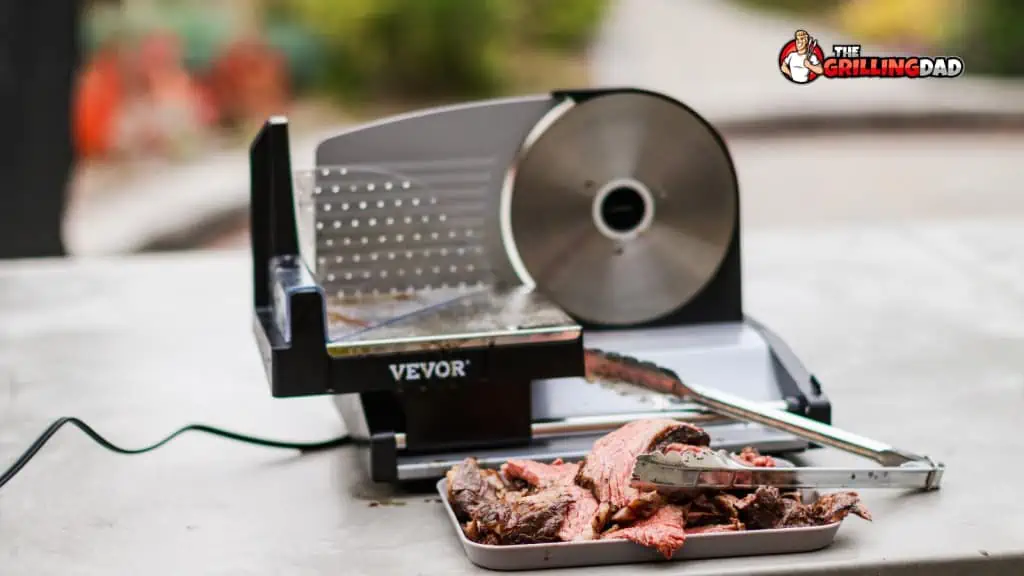
|
|
$67.99
|
$368.00
|
|
Primary Rating:
4.9
|
Primary Rating:
4.7
|
Primary Rating:
4.8
|
|
|
||
Jump to Section
My Ratings of the Best Meat Slicers
Here are my top 10 best meat slicer ratings! Keep reading to discover more about my top picks:
- Best Overall Meat Slicer: Vevor 10″ Commerical Meat Slicer
- Best Budget Pick: Vevor 7.5″
- Best High-End Meat Slicer: Beswood 10″
- Best Small Option: Ostba 7.5″
- Best Rust-Resistant: Elite Gourmet 7.5″
- Best Entry Level: Midone 7.5″
- Best for a Small Restaurant: Chef’sChoice 7″
- Best Grillside: Nesco 8.7″
- Best Compact: Weston 9″
- Honorable Mention: Techwood 9″
Best Overall Meat Slicer: Vevor 10″ Commercial Meat Slicer
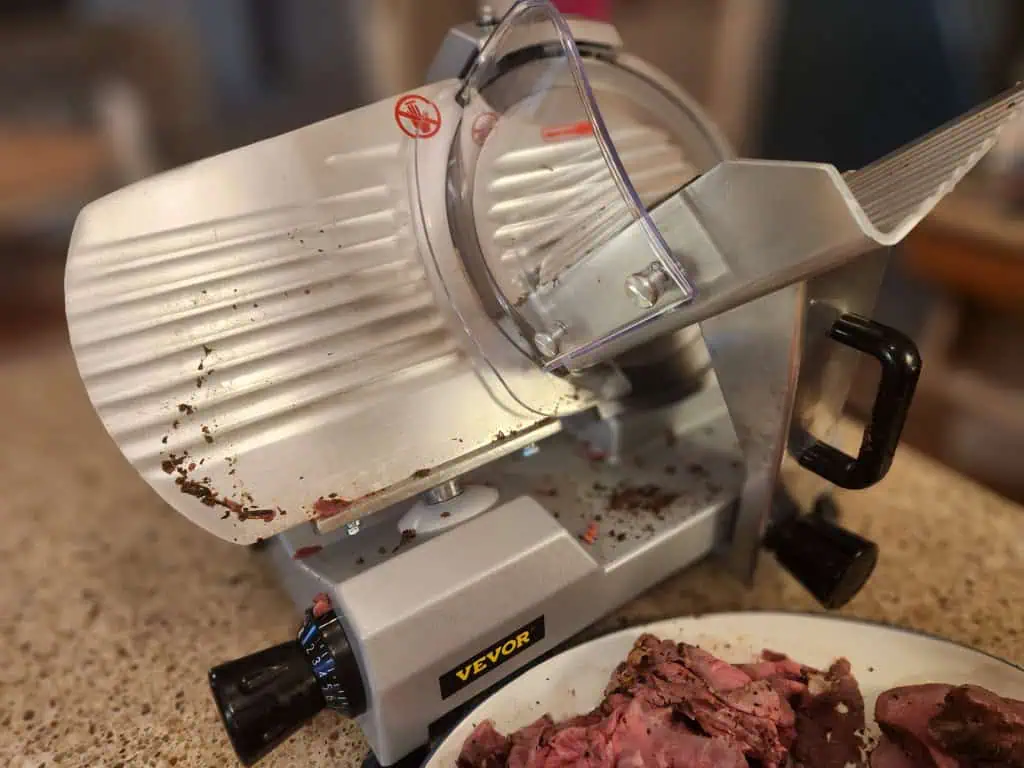
Pros
- Built to last a lifetime
- Unexpectedly quiet
- Can cut extremely thin or thick
- The most consistent and smoothest cut
Cons
- It has a hefty price tag
The VEVOR 10” Blade Commercial Deli Meat Slicer can help you serve up a storm with its high-powered motor and 10-inch stainless steel blade.
What stands out are two things: 1) how quiet it operates (see the clip below), and 3) how easy it is to sharpen this electric meat slicer. It comes with built-in whetstones that allow you to sharpen the blade quickly without removing it.
This thing is a beast and has a matching price tag, so this is not for the newbie BBQer. But for those looking to add a durable meat slicer to their arsenal, this is the one for you.
Read My Full Review: Vevor Commercial Meat Slicer Review
Best Budget Pick: Vevor 7.5″ Meat Slicer

Pros:
- Commercial-grade quality suitable for home use
- Easy to use and clean
- Offers precise cuts
- Has safety features, including a blade guard and a non-slip base
Cons:
- Relatively heavy, which could make it difficult to store
- Relatively noisy compared to higher end models
The 7.5″ Vevor Meat Slicer is a commercial-grade meat slicer that is suitable for home use. The biggest differences between this and the 10″ model above are:
- The blade and overall size is smaller
- This one has some parts made of plastic whereas the 10″ is all metal
- This one sounds slightly louder when operating
The slicer is easy to use and clean, and it offers precise cuts. The slicer also has safety features, including a blade guard and a non-slip base.
Overall, the 7.5″ Vevor Meat Slicer is a high-quality product that is worth considering for home use.
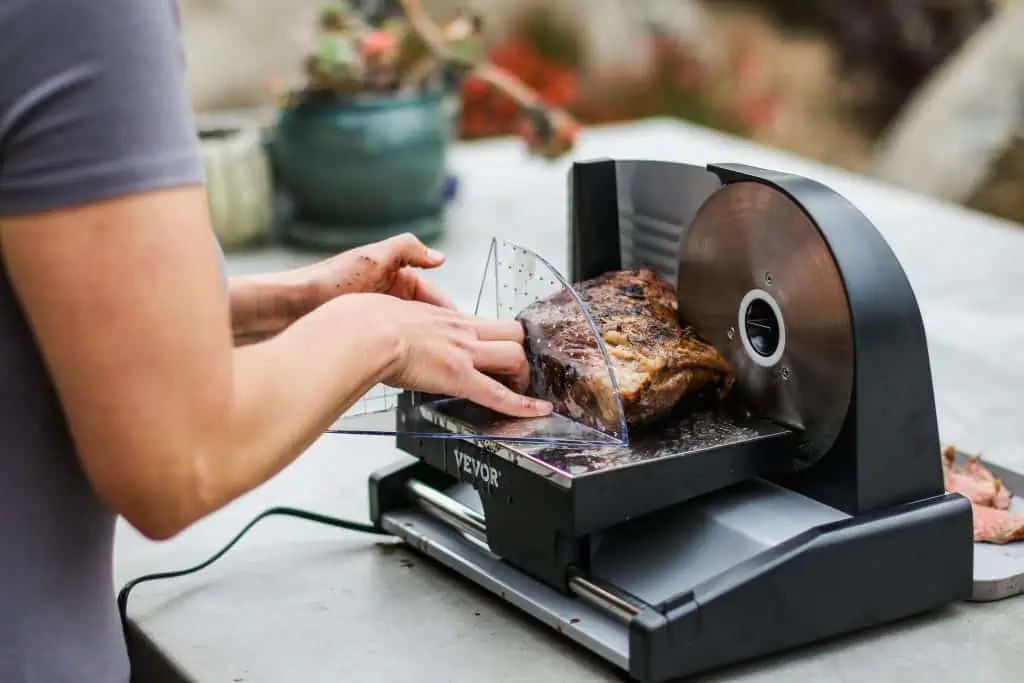
Read My Full Review: Vevor Commercial Meat Slicer Review
Best High-End Meat Slicer: Beswood 10″ Electric Meat Slicer
Commercial-grade and industrial-grade meat slicers usually cost four digits.
But that’s not the case here.
Pros
- Chromium-plated carbon steel blade
- Blade stays sharp forever
- Comes with a handy cleaning brush
- Quiet motor packed with power
- Smooth and consistent slices
Cons
- Its price tag is more than most want to spend for home use
The BESWOOD 10” Chromium-Plated Meat Slicer is a home-use meat slicer that can hold its own against its commercial counterparts.
This food slicer boasts a stainless steel and aluminum exterior that gives you maximum durability and longevity.
Its long 10” is powered by a low-noise motor, making your meat slicing a near Zen-like experience.
If budget isn’t a concern, this is a great high-quality option.
Best Small Option: Ostba 7.5″ Electric Meat Slicer
Pros
- Easily adjusts for thickness
- Great safety child lock
- Sharp and durable
- Everything you want for a home meat slicer
Cons
- More of a nag, but I wish the food pusher was also metal instead of plastic
Let’s kick off this top 10 list with one of my favorites, the OSTBA Electric Deli Meat Slicer.
This meat slicer is made of durable cast iron and is equipped with a 7.5” stainless steel blade.
Measuring only 14.17 x 9.65 x 10.24 inches, it’s a pretty compact meat slicer. However, don’t let the size fool you.
The OSTBA Electric Deli Meat Slicer comes equipped with a set of serrated blades powered by a ⅕ -horsepower motor.
This compact, electronic meat slicer gives you the most bang for your buck for a durable, powerful, yet affordable meat slicer to use at home.
Best Rust Resistant: Elite Gourmet 7.5″ Electric Meat Slicer
Budget-friendly options have always had a bad rep for being subpar and short of durable. In most cases, this isn’t an inaccurate assessment.
Pros
- Rubber feet for stability
- Adjustable thickness
- Sharp stainless steel blade
Cons
- It’s not as easy to clean as other units are
- Some small pieces of the meat shred after a few passes
If you’re looking for a meat slicer that’s worth a small investment, look no further than the Elite Platinum EMT-625B Meat Slicer!
Die-cast prevents all possibilities of rust, ensuring that you get years out of this meat slicer. The easy-flick design also allows you to easily adjust the thickness of your blades.
With a ready instruction manual and safety guide, the Elite Platinum EMT-625 B Meat Slicer has a near-flat learning curve.
Perfect for a beginner that’s never used a meat slicer.
Best Entry Level: Midone 7.5″ Electric Meat Slicer
Pros
- Comes with an extra blade
- Dual safety feature – great with kids running around
- Metal food pusher feels commercial-grade
Cons
- The slide tunnel needs to be cleaned very frequently to keep the slide moving smoothly, and it’s not super easy to get to
Here’s another one of my favorites.
Other than its affordability for entry-level grillers, the Midone Electric Meat Slicer boasts many features for grillers of all levels.
Made of stainless steel, this meat slicer has a safe lock with replaceable blades. This means you won’t have to rush cleaning blades before a big barbeque.
Its hand push mechanism is one of the most durable in the market. You won’t have to worry about it breaking as you slide meat closer to the blade.
With most parts being easily removable, cleaning it is a breeze.
Best for a Small Restaurant: Chef’s Choice 7″ Electric Meat Slicer
A meat slicer for home use is great.
However, how about one that you can use for your grill and a small restaurant?
Pros
- All metal components
- Compact design for counters
- Tilted, so it’s very easy to use
Cons
- I had to replace a fuse after a few uses. Since then, it’s been back to slicing. Fingers crossed.
The Chef’s Choice 615A Electric Meat Slicer is a solid pick.
This impressive meat slicer falls in the middle of the pack as far as price. Nonetheless, with the workload it can handle, it might be worth the investment for you.
This food slicer is a medium-grade slicer, equipped with a motor powerful enough to cut through most types of meat.
Its easily removable parts also make it easy to clean and maintain.
The Chef’s Choice Meat Slicer also comes with a set of blades you can change for high-volume barbequing.
Did I get your mouth watering?
Check out the Chef’s Choice 615A Meat Slicer in all its glory on Amazon!
Best Grillside: Nesco 8.7″ Electric Meat Slicer
A serrated blade and a powerful motor make the NESCO FS-250 Stainless Steel Food Slicer impressive right at the grill and in the kitchen.
Pros
- Huge, sharp blade
- Two safety features
- Heavy duty slicing guard
Cons
- The thickness dial is not as consistent or as heavy-duty as I expected
This food slicer is made of both aluminum and stainless steel, ensuring premium durability.
The NESCO FS-250 Meat Slicer comes with a 180-watt motor. In horsepower, that’s about ¼ HP, meaning it can handle tough cuts of meat and for longer.
A heavy-duty slicing guard protects your fingers.
In addition, you’ll be impressed with the in-chassis switch that prevents you from tripping it accidentally.
Best for Compact Spaces: Weston 9″ Electric Meat Slicer
Pros
- Suction cup feet for sturdiness
- Really quiet motor
- Easy to understand thickness control
Cons
- With such a large blade, I expected the carriage the meat sits on to be bigger
- It wasn’t great at super thin slices (size 5 and bigger were fine, though)
Weston’s Electric Meat Slicer is as compact as they come.
At only 10 x 17 x 12 inches, this meat slicer weighs less than 13 pounds.
What it might lack in size is compensated by what it is capable of.
The six-inch blade cuts meat into thin slices. This is great news if you’re into bacon, ham, and fish.
Also, you’ll be impressed at how smoothly meat glides on the tray to the blade.
This food slicer is an example of how compactness and performance can coexist.
Honorable Mention: Techwood 9″ Electric Meat Slicer
Pros
- Can swivel for easier cutting
- All the parts are dishwasher safe
- Compact design; fits on the kitchen counter
- Razor-sharp blade
Cons
- It’s compact, but has no foldable parts for storage
- The blade has a slight wobble, but cuts perfectly fine
Modern craftsmanship and a ¾-HP motor are the main selling points of the Techwood Electric Meat Slicer.
Its nine-inch stainless steel cutting blade is built closer to the slicer’s body. This makes cutting meat a no-mess no-fuss affair.
On top of that, the ¾-horsepower motor allows you to use this meat slicer for much longer and more frequently. You don’t need to worry about the meat slicer’s motor running hot.
The compact and modernized design ensures that cleaning will be easier. In no part of the food slicer can chunks of meat get stuck.
What Should You Look for When Buying a Meat Slicer?
When buying a meat slicer, you should look for a stainless steel blade, a slicer that will fit your budget, a motor that is strong enough to slice the meat you want, and safety features.
In reality, choosing from a variety of home slicers can result in some paralysis by analysis. That is, you’ll be frozen in a state of indecision as you weigh your options.
As a passionate griller and dad, I believe in making these kinds of choices clear-cut (pun intended).
So, I’m going to narrow down your choices further by filling you in on what to look for in a slicer.
Whenever I’m shopping for an electric meat slicer, I pay close attention to:
- Meat slicer blade
- The motor
- Price
- Safety
- Learning curve (yes, it exists — at least, for some models)
The Meat Slicer Blade
The blade of a food slicer matters. Why wouldn’t it? It is a slicer, after all, right?
When it comes to the blade, what you’re really looking at is the size. The slicer you’ll get needs to be up to the task. However, you don’t want one that’s unnecessarily large or heavy-duty.
If you’re the type of person who grills frequently, then maybe you’ll want a food slicer with a heavy-duty blade. Heavy-duty blades can be a foot to 14 inches in length.
Then again, if you’ll only be hosting one or two barbeques every fortnight, an entry-level slicer will do just fine. By entry-level, I’m talking about food slicers with blades that measure less than 11 inches.
Aside from the blade’s capacity, you’ll have to look at the material. Be wary of meat slicers that have blades made of anything but stainless steel. Stainless steel may cost just a tad bit more. Nonetheless, the years you’ll get out of it will be worth the investment.
Keep in mind, the height of your food will max out at about 2″ smaller than your blade, which means:
- 10-inch blade can slice food up to 10-inches high
- 8-inch blade can slice food up to 6-inches high
- 7-inch blade can slice food as tall as 5-inches
Read More >> Best BBQ Knife Sets
The Motor
When looking at a meat slicer’s motor, I look not at its specs but the power output. Why output? This is because the power output determines how long I can use the slicer.
Here’s the thing with meat slicers. More output means longer use. On the other hand, slicers with lower motor outputs can only be used for a short while and intermittently.
Power output is expressed in HP or horsepower. Entry-level meat slicers usually have motors capable of churning out ⅓ to ¼ horsepower. These are usually for easy cutting. We’re talking about cutting meat like wagyu or other thinner cuts of meat. Also, you can only use these for a few minutes at a time.
Higher up on the spectrum are medium-level meat slicers capable of ⅓ to ½ horsepower. You can get at least a couple of hours out of these meat slicers. You’ll be able to cut most meats and cheeses.
Now, if you’re looking for some heavy-duty meat slicing, go for the industrial-grade ones. These have the highest power outputs of any electric meat slicer. What can you cut? Well, you’ll be able to slice just about any slab of meat. Of course, with higher output comes a heftier price tag. This is something you may want to factor into your purchasing decisions.
This brings us conveniently to the discussion on price.
Read More >> Best Steak Knives
A post shared by Shawn Hill | The Grilling Dad (@thegrillingdad)
Price
With anything you want to add to your grilling or kitchen setup, you need to consider the price. Sure, it’s ideal to get the best meat slicer you can get your hands on. However, the “best” isn’t always cheap. Then again, the best meat slicer for you doesn’t have to break the bank either.
It comes right down to how much you’re willing to spend and what you need. This is something you’ll have to decide for yourself. If you were to ask me, I’d say don’t go for anything too high-end if you don’t barbeque often.
Also, don’t skimp on a medium-range electric meat slicer if barbequing is a passion or hobby of yours. It’s that sweet spot in the middle where you’ll find the right balance between price and utility.
Safety
Not all food slicers are the same as regards safety features. Some have blade guards. Others don’t. Whatever the case may be, you’ll want an electric meat slicer that slices meat, not fingers.
If that does happen, follow these steps from Healthline.
When it comes to staying safe, a good pair of gloves may be a useful addition. However, if safety measures are already part of the food slicer, gloves may be optional.
How Easy It Will Be to Use the Meat Slicer
Lastly, look into whether it’ll take you a while to get the hang of a particular food slicer model. In the market, you’ll find two types of electric meat slicers: manual or automatic.
Automatic meat slicers may be easier to use in the sense that you don’t have to manipulate the blade. All you need to do is ensure that the meat is placed securely on the tray.
However, the prep time to start an automatic meat slicer may be an issue to some. For some models, an instruction manual is required — and, luckily, provided.
On the other hand, if you’re looking for something a bit old-school and intuitive, a manual food slicer may be for you. Sure, you’ll have to manipulate the blade with almost every cut. However, let’s face it. Who needs an instruction manual for something like this?
Whatever the case may be, one may be easier to use for you. Go with the one that you think will play to your culinary strengths (or lack thereof).
Read More >> How To Slice Brisket
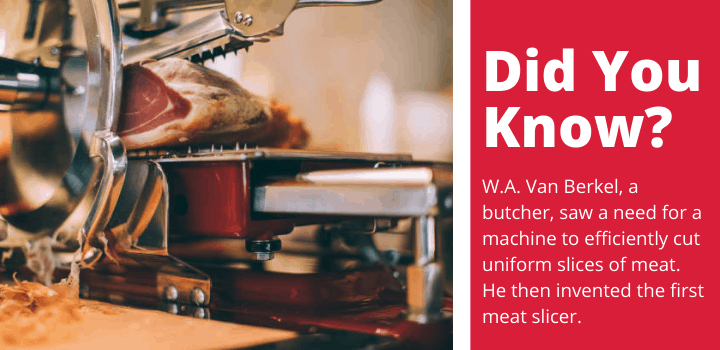
Meat Slicer FAQs
I’ve scoured several online forums looking for the most commonly asked questions about meat slicer usage. Without getting caught up in the technical details, I’ve also come up with my own responses.
My responses are based mainly on experience. Hopefully, you find this information useful!
I’ll be answering the following:
- “Is buying a meat slicer worth it?”
- “How can I prevent cross-contaminating my meat?”
- “Will my meat slicer cut meat that’s taken fresh off the freezer?”
- “Can I use a meat slicer to cut bones and joints?”
- “Can I sharpen the blade of the meat slicer?”
- “How do I clean a meat slicer?”
Is Buying A Meat Slicer Worth It?
Buying a meat slicer for around $200 is worth it because it creates a good balance between performance and safety features.
If you eat a lot of sandwiches like my family does, you can justify the purchase after just a couple uses!
How Can I Prevent Cross-Contaminating Meat While Using a Meat Slicer?
Cross-contamination does happen — particularly whenever you use the same surface or blade for different types of meat.
Cross-contamination while using a food slicer can happen whenever you cut contaminated meat and then cut the one you’re about to consume. If you’ve only got one food slicer and not enough time to clean it in between meat preps, cut seared or cooked meat first.
How done is “cooked” or “seared”? This is where your meat thermometer comes in handy. You’ll want meat like beef, pork, or chicken to be anywhere from 160 °F to 165 °F. Cutting meats at this temperature first will prevent cross-contamination.
Once you’ve cut your cooked or seared meat, you may now move on to the uncooked or frozen meats. And, this brings us to the next FAQ about meat slicer usage.
Will My Meat Slicer Cut Meat That’s Taken Out of the Freezer?
The short answer to this question is “yes”. However, it isn’t something I’d recommend unless you’re using an industrial-grade meat slicer.
Thawed meat or raw meat may not be a problem for medium-grade and entry-level meat slicers. However, frozen meat is bound to be tougher. For this reason, trying your utmost to slice them can result in your blades dulling or being damaged.
For me, I’d prefer to thaw the meat and sear it to 160 °F to 165 °F before slicing it. You’ll prevent cross-contamination, as mentioned earlier. This way, you’ll be saving your meat slicer’s blades.
In short, thaw or cook your meat before putting it under a food slicer. Once again, the exception is if you’re using an industrial-grade meat slicer, of course.
Can I Use a Meat Slicer to Cut Bones and Joints?
You’ll get a variety of answers on various forums. My answer is a resounding “no.” It all has to do with what can happen to your blade whenever you try to cut something that’s too hard.
Indeed, most meat slicers may be able to cut through bones. However, just as in the case of cutting frozen meat, the blade will be dull.
You might be able to get away with cutting chicken joints. Be that as it may, you’ll probably be better off doing the task with a butcher’s knife. It isn’t just better for your meat slicer’s blade, but it will also save you time.
Can I Sharpen the Blade of a Meat Slicer?
Sharpening the blade of a meat slicer may seem different from sharpening a knife. However, the principle is similar.
When you get a food slicer, there’s a chance that it comes with a care kit. The care kit contains everything you will need for sharpening and cleaning your meat slicer’s blade.
When you buy a meat slicer, ask the salesperson if it comes with a care kit. If it doesn’t, you either find a different model that has one or you buy a separate kit.
Before you sharpen your meat slicer, clean the blade thoroughly. Once you’ve done that, use some of the blade sharpening oil that came with the kit. Adjust the blade against the surface of the sharpening edge and simply sharpen until you’re content with the edge.
In sharpening a meat slicer’s blade, here’s a mistake that I don’t want you to commit — oversharpening. Doing this can reduce the lifespan of your blade. It will cause your stainless steel blade to either become blunt or brittle.
How Do I Clean a Meat Slicer?
Cleaning your meat slicer is crucial to preventing contamination and adding years to your blade. To do this, you will need two things:
- Sanitizer or anything alcohol-based and antimicrobial
- Water (preferably lukewarm)
Sanitizer is best for cleaning anything made of stainless steel. As you clean your blade, be sure to use gloves. You don’t want to cut yourself, do you?
Besides the blade, you’ll need to ensure that you lube your meat slicer’s moving components. Don’t try to use EW40 for your meat slicer. After all, it handles food. The last thing you want is the taste of petroleum on your pork chops.
Use a food-grade lubricant for meat slicers. These are available in many places including grocery stores. Chances are your local seller has them too — or they know where you can get them.
Is it cheaper to slice your own meat?
Slicing your own meat with a meat slicer can be a cost-effective solution since you can take affordable cuts of meat and slice them into thin deli cuts that are typically more expensive when pre-sliced.
This can potentially save you thousands of dollars in the long run depending on how much deli meat you eat.















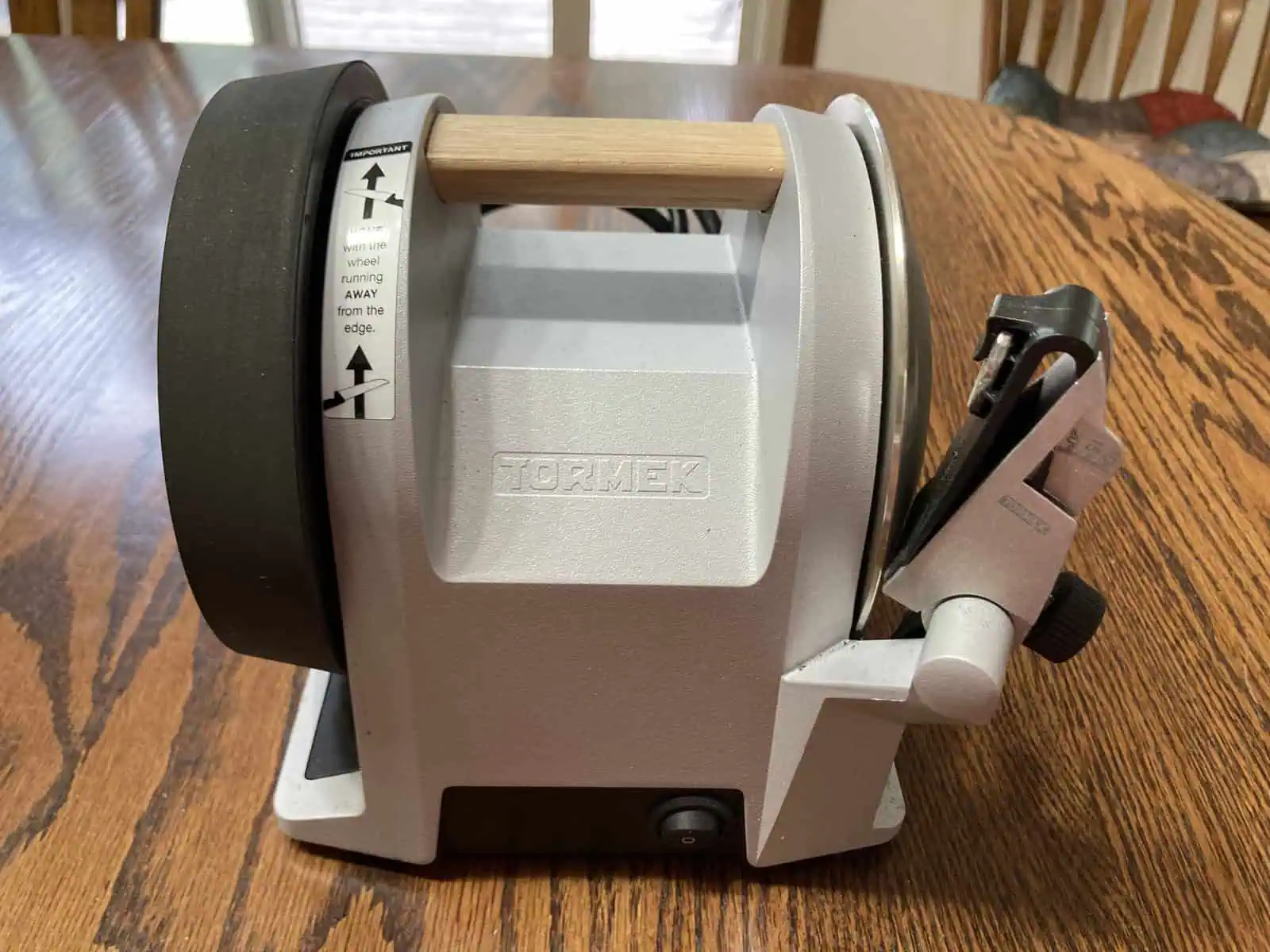

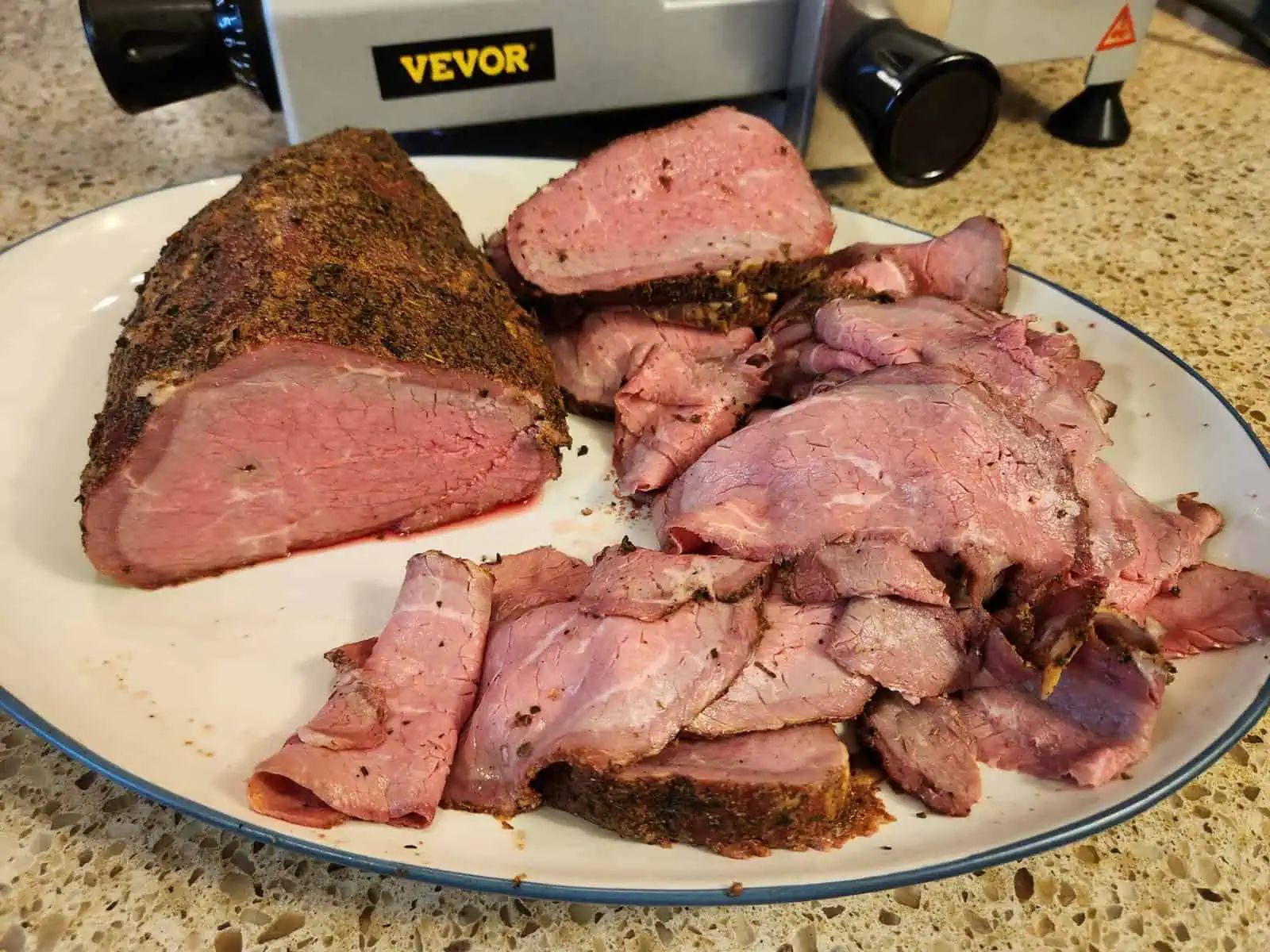
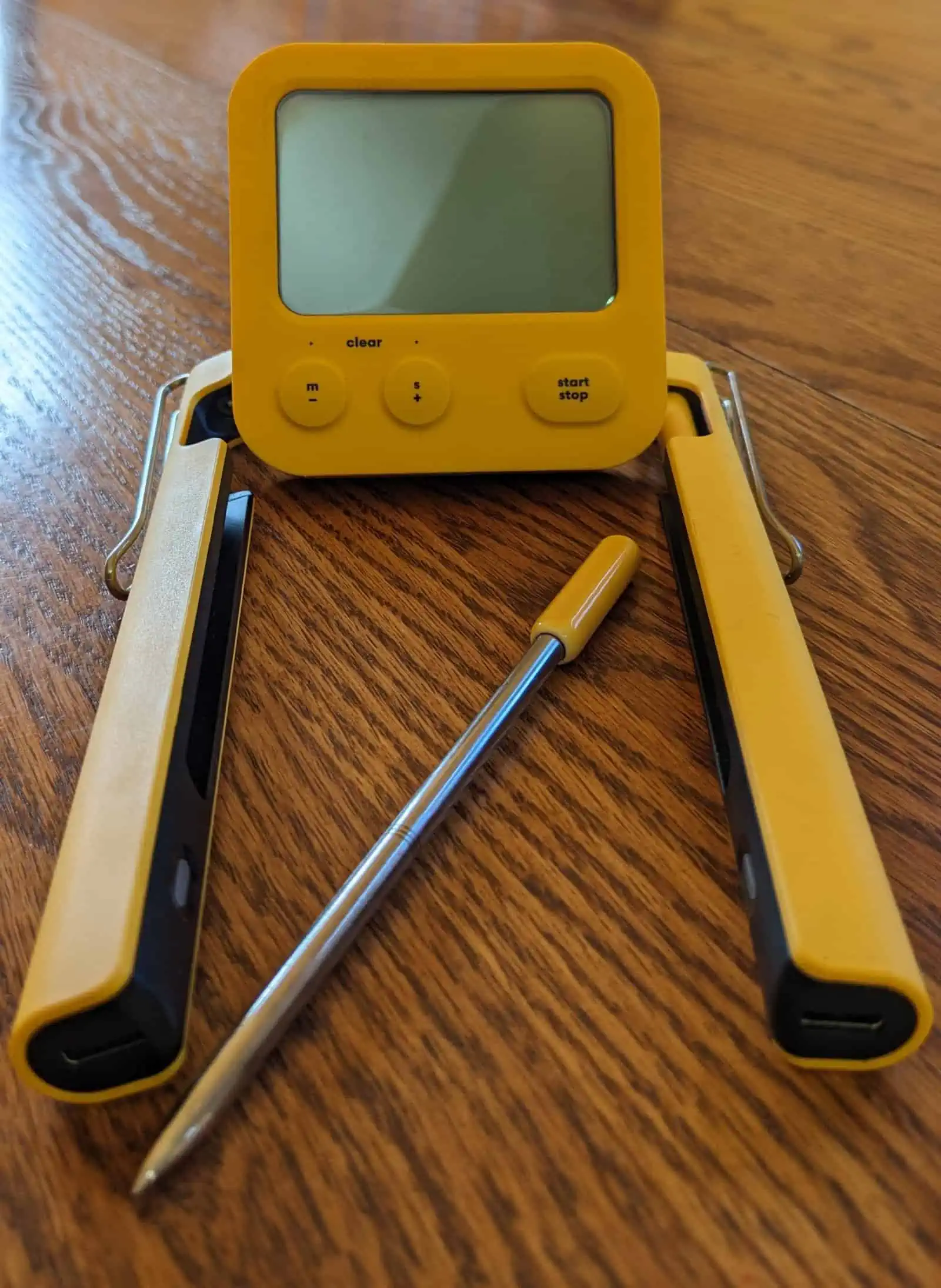
Hello! I am in the market for a new electric meat slicer and found your site. I had a Chef’s Choice electric slicer for a few years. I bought it on Amazon being influenced by positive reviews. The truth about this piece of literal junk came about when the plastic circle that holds the blade cracked and the company does NOT offer a replacement part!! I called and emailed the company a dozen times with no one answering the phone or replying to my emails. So strange. I then read the negative reviews on Amazon and there were a large number of customers with the same complaint about the exact piece and no response from the company. I did a search on the internet and found the same complaints. I had invested in what I thought was a reputable and dependable product. It may have served me well for a few years, and only occasionally, but at the cost, Chef’s Choice should have done what was upright and stood behind their product. I wanted you to know about my personal experience with this company’s product, as they are one of your offerings in this article. Thank you for your valuable time in reading. Mary H
Wow. Thank you for taking the time to add your experience here, Mary. We will take this into consideration as we update our posts.
How is the cleanup on the Vevor 10″, or Beswood 10″?
Hey Jeremy – They both come apart nicely. There’s a video I’d recommend for the Beswood. The guy does a great job walking thru it just to give you an idea… https://www.youtube.com/watch?v=nO0cwV_3OFA. Start at the 7:30 mark
one thing i am missing in all this is about weather they have a gear drive an if it is just cheap plastic drive looking for a metal gear drive they may not be as quiet biut will out last me
I well… I haven’t taken it apart. But I’ll reach out to Vevor and find out
The Beswood (and similar KWS) use a belt drive that is extremely quiet and better than a gear drive. The downside of the Vevor is you CANNOT buy dare parts (including replacement blades).
The belts and motor can be replaced, as can the power switch, carriage, and other parts. KWS has more parts available, including replacement carriage rails.
The blade alone will last years to decades depending on how often you use the integral sharpener.
Aaron,
Thanks for this awesome feedback and insights!